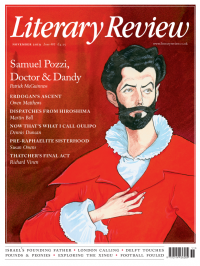Jerry White
Man About City
Short History of London: The Creation of a World Capital
By Simon Jenkins
The publication of a new book by Simon Jenkins is always an event, and one about London doubly so. No one knows more about modern London and few have written about the city so winningly. His Landlords to London (1975) is a classic, indispensable to anyone who wants to understand the mechanics of London’s development over the past 350 years. Now he has turned his attention to the whole of the capital’s two thousand years. A Short History of London ranges from the city’s Roman origins right up to the present day. Quite a few historians have travelled this immense terrain since Roy Porter’s London: A Social History appeared in 1994 and some (Porter, Stephen Inwood, Michael Hebbert) have made a very good job of it. But a ‘short history’ well done will have a special appeal, and for any reader seeking to understand how London became what it is today, especially how it looks on the ground, Jenkins’s book will be an essential stepping-off point.
Jenkins starts at a gallop but over the course of the book slows to an amble. There are six pages on the Roman city and eight on the period between the withdrawal of the Romans and the Norman Conquest, key years that saw the emergence of a rival city to London at Westminster and the beginning of a conflict between the two that would drive metropolitan growth for the next seven hundred years. Another eight pages take us to the late 12th century and the building of Peter de Colechurch’s great London Bridge, which in effect opened up a third city south of the Thames. In a nearly 400-page book (it’s not that short), the first millennium and more of London’s existence is disposed of in just thirty pages or so. On any balance sheet, that must count as slim pickings. It would have been helpful for the general reader if the peremptory ‘further reading’ list at the end of the book had been supplemented by more in-depth, chapter-by-chapter recommendations.
Time begins to lengthen, and space to expand, when Jenkins reaches the ‘Age of Chaucer and Whittington’, an era of plague and rebellion that ushered in an extended period of drama and turbulence. The Tudor and Stuart dynasties brought internecine murder to the streets of London in the

Sign Up to our newsletter
Receive free articles, highlights from the archive, news, details of prizes, and much more.@Lit_Review
Follow Literary Review on Twitter
Twitter Feed
Literary Review is seeking an editorial intern.
Though Jean-Michel Basquiat was a sensation in his lifetime, it was thirty years after his death that one of his pieces fetched a record price of $110.5 million.
Stephen Smith explores the artist's starry afterlife.
Stephen Smith - Paint Fast, Die Young
Stephen Smith: Paint Fast, Die Young - Jean-Michel Basquiat: The Making of an Icon by Doug Woodham
literaryreview.co.uk
15th-century news transmission was a slow business, reliant on horses and ships. As the centuries passed, though, mass newspapers and faster transport sped things up.
John Adamson examines how this evolution changed Europe.
John Adamson - Hold the Front Page
John Adamson: Hold the Front Page - The Great Exchange: Making the News in Early Modern Europe by Joad Raymond Wren
literaryreview.co.uk